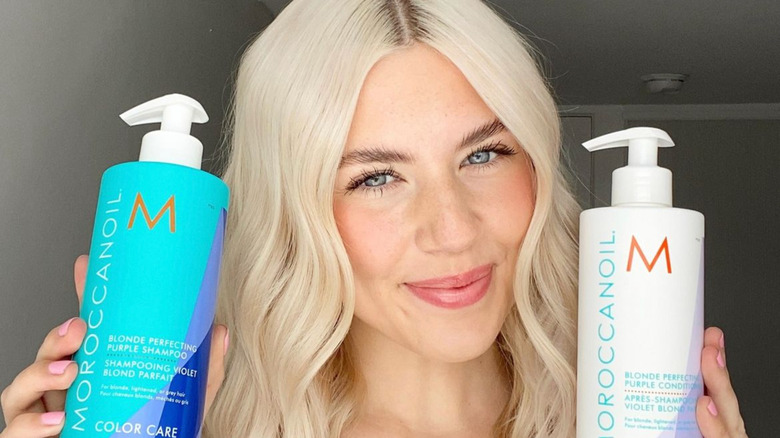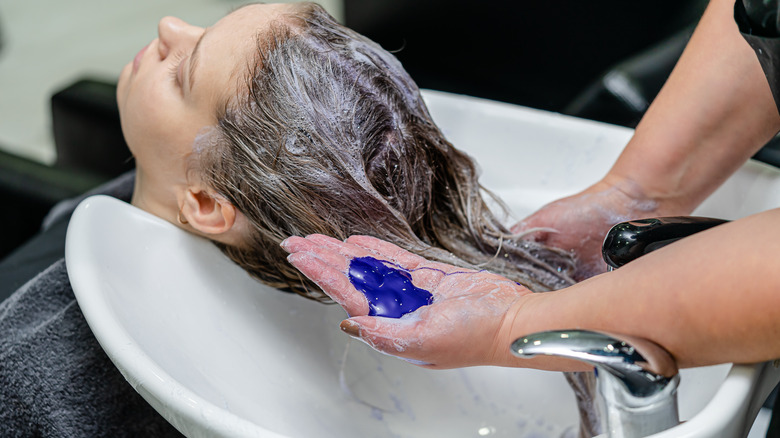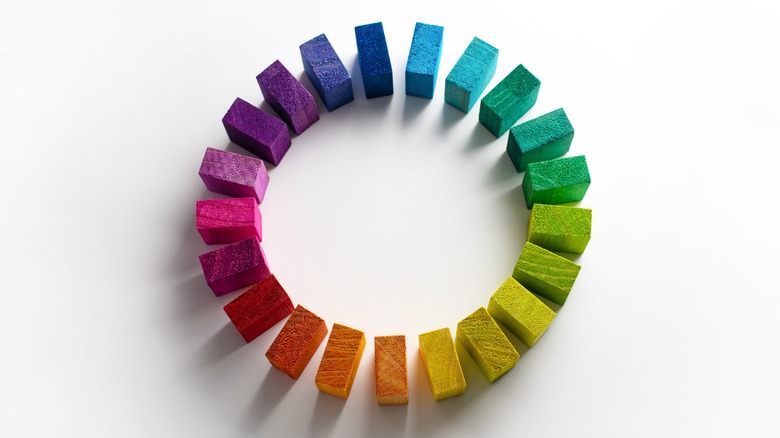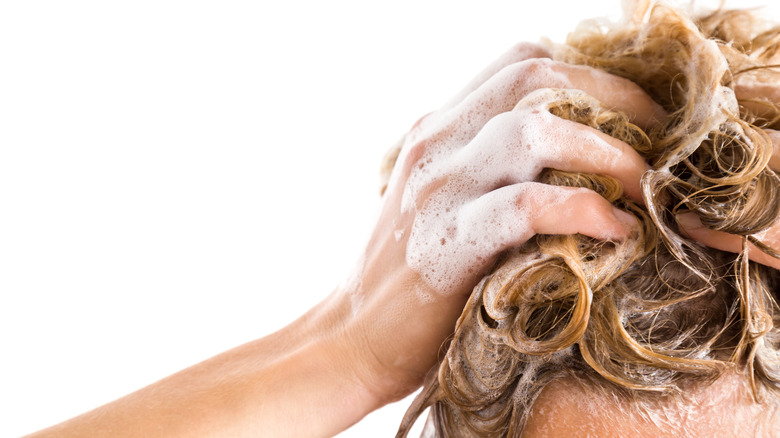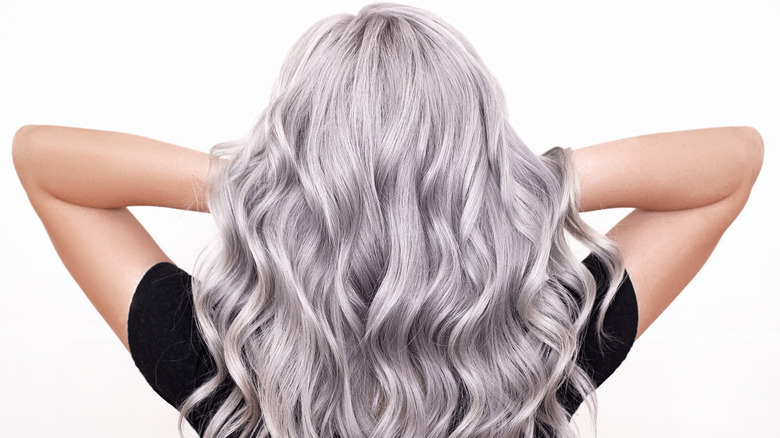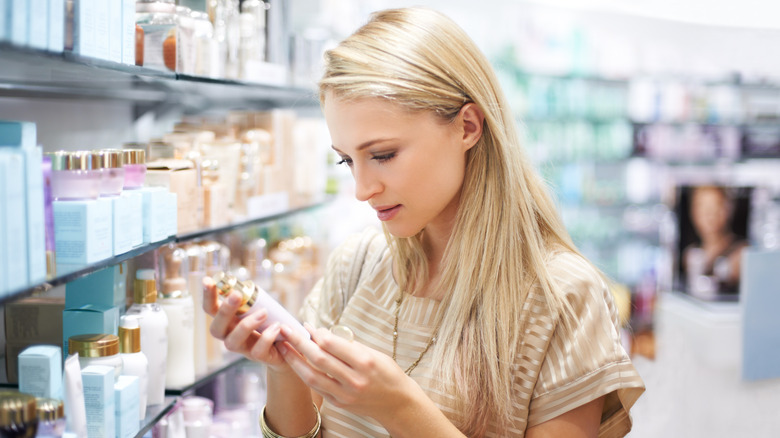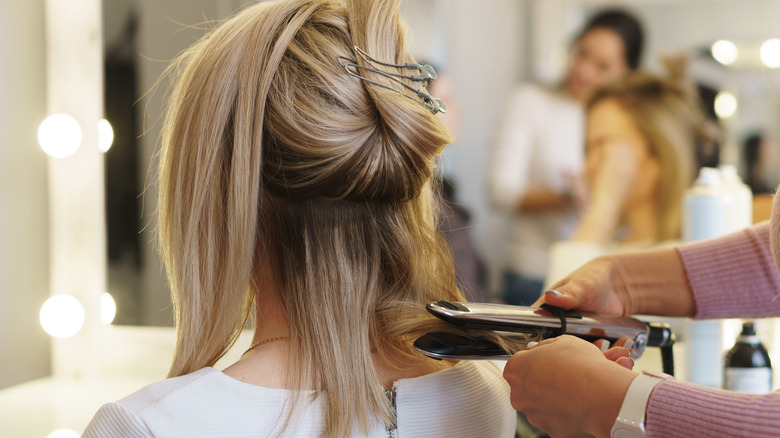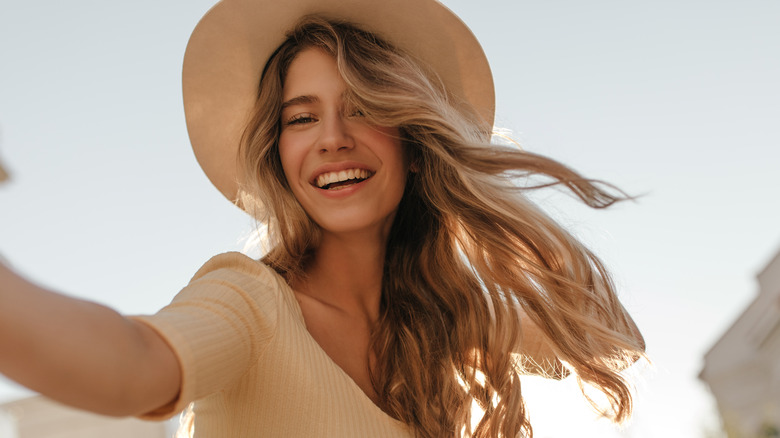The Hair Benefits Of Purple Shampoo For Blond Babes
Although the jury is out on whether or not blonds do have more fun, one thing is for sure — it takes a little more finesse than most people realize to keep those locks looking their best. There are simply many environmental and color-treatment factors that come into play where hair is concerned. While a gifted stylist can stave off unwanted brassiness for a time following a salon visit, eventually the toner will wear off, leaving blond hair looking dull, brassy, and even a little bit trashy. Since most people can't afford a trip to the salon every couple of weeks, it becomes necessary for them to figure out alternative methods of blond hair maintenance.
Fortunately, the hair care industry has taken note of the need for blond hair treatment options. These shampoos, conditioners, and masks show up at a variety of price points, with brands like Joico, Redken, L'Oreal Paris, and many others saturating the marketplace. Learning how and why to use purple shampoo doesn't have to be a stressful experience though.
This is what purple shampoo is
Purple shampoo (and related purple products, for that matter) are designed specifically to get rid of yellow and/or brassy tones from blond hair. It's not unusual for this color change to occur a couple of weeks post-salon visit. When the initial color is done, the stylist typically applies toner to the hair to achieve the type of blond you're looking for. Toner gets rid of brassiness and helps the hair adjust to this new hue.
However, toner doesn't last forever, and in fact, its effectiveness is lessened by lots of hair-washing. Some of that can be offset by the use of purple shampoo, which is very true to its name in that it's a vivid purple color. The idea behind purple shampoo is that it can keep the hair toned and prevent brassiness from popping up with regular use. Or, it can be used to reverse brassiness if it's already snuck up on you.
How does purple shampoo help to keep blond hair balanced?
Most people are familiar with the color wheel, which shows how various hues interact with each other. Yellow and purple are opposite from each other on the color wheel, which is why violet pigments are adept at canceling out unwanted yellow and brassy tones. Purple shampoos contain toning violet pigments, which neutralize brassy or yellow tones in the hair. Initial toning is done at the salon to counteract the hair's natural tendency to go yellow when its natural color is stripped.
The brassy tones show up because there are too many warm pigments in the hair, which is typically caused by hair coloring and/or bleaching. Although brassiness shows up as orange or yellow where blonds are concerned, brunettes can fall victim, too. They just tend to have red or orange brassy tinges, instead. The issue is quite a lot more noticeable on blonds, however.
How should purple shampoo be used?
Most purple shampoos are formulated to work best in tandem with either a purple conditioner or a deep-hydrating purple mask. Always read the label's instructions, as some of them are so vibrant that wearing gloves is recommended. No one wants to stain their fingernails by accident.
In general, most purple shampoos have the same instructions. First, get the hair nice and wet. Work purple shampoo into a lather on the hair, then allow it to sit for a couple of minutes before rinsing. The brassier the hair, the longer you should wait. Then, thoroughly rinse the hair, as unrinsed purple products will leave locks with a violet tinge. Lastly, use a purple mask or conditioner to counteract any harsh effects and leave hair healthy and strong.
Some purple shampoos are meant to be used daily until the desired color has returned, but a lot of experts recommend starting product use at once a week to see how it goes. Once the ideal tone has returned, it's best to alternate purple products and your regular shampoo/conditioner combo.
Who can use purple shampoo?
Obviously, people with color-treated blond hair or highlights are the first ones we think of in relation to purple shampoo. However, they're not the only candidates for these helpful products. In fact, people with natural blond hair can also wind up looking all brassy thanks to environmental factors. Those with other types of light-colored hair, like people with real or color-treated platinum, gray, white, or silver hair can also benefit from purple shampoo's toning power.
So anyone with light hair who notices it starting to dull or warp to an unsightly yellow or orange tinge can easily look into purple shampoo to offset the unwanted color. This will return the hair to the cool tones you're looking for, although it might take a few applications to really get the job done. Remember that extremely light hair can really soak up that purple color, so if you notice that you're less brassy but more purple, simply wash your hair again with a clarifying shampoo, followed up with conditioner. That should remove any violet tones quickly enough.
How to choose a purple shampoo
Now that the word it out about the benefits of purple shampoo, the marketplace is naturally saturated with options. But like many other products, all purple shampoos are not created equal. Experts say to avoid purple shampoos that are not vividly purple in color. In addition to being really, almost startlingly bright, a high-quality purple shampoo should be pretty thick. Thin, translucent purple shampoos will simply not get the job done to the same level.
In addition to the obvious violet pigments, there should also be some sort of hydrating ingredient (or two!) to keep the hair healthy. Some that are commonly found in purple shampoo include coconut fatty acids and açai extract. Many people also feel strongly about avoiding products that contain ingredients like parabens, sulfates, excessive synthetic fragrances, and formaldehyde. Then, of course, there's the question of price points. Fortunately, there are many options in the marketplace at a range of prices, so you should be able to find a purple shampoo and conditioner combo that meets your needs but doesn't break the bank.
These hair care factors are murder on blond hair
Exposure to certain elements will make blond hair become brassy more quickly. Believe it or not, one of the most common culprits for brassiness is in your own shower! First, everyone enjoys a piping hot shower, but excessively hot water will cause salon toner to fade more quickly, so try whenever possible to shower with cool water. Also, those people with high mineral levels in their home water definitely turn brassy faster. If that's the case, purchase a filter that gets rid of minerals and attach it to your shower. Otherwise, wash your hair less often to reduce exposure to harmful minerals.
Heated styling tools also turn locks brassy, so if you must use them be sure to apply a heat-protectant spray or balm beforehand. This goes for all types of heated tools, including hair dryers, curling irons, straighteners, and so on.
How to keep outside elements from turning hair brassy
Sun exposure is another key cause of brassy hair. This is because ultraviolet rays and oxygen bring out the warm tones that are just dying to peek through. Whenever you're out in the sun, opt for a hat to protect your tresses from these harmful elements. The less time the sun beats down on your hair, the healthier it will be. Plus, you'll have the added benefit of protecting the skin on your face from potentially cancer-causing rays.
Lastly, avoid chlorine like your life (or your hair) depends upon it. Chlorine will not only dry out hair, but it will also turn it yellow in a big hurry. If you must go underwater at a pool without a bathing cap, pour a bottle of water on your hair first. The hair will soak this up, and less of the harmful pool chemicals. Then, make sure you shower with shampoo and conditioner as soon as you exit the water.
